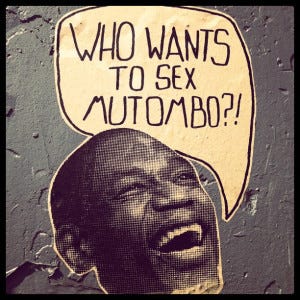Currygoat wrote:Rim protection is way better now not even close. Honestly 90s defense was overrated. Someone post the Jordan 90s d video lmao. In before old heads bring up block stats
Watching Jordan highlights dramatically undersells the quality and value of rim protection in the 90s. Part of what makes Jordan highlights so compelling to the folks who saw him live is the
culture of rim protection, and the direct battle of individuals that was talked about long before and after the game.
Players like Shawn Bradley and Manute Bol are prime examples of the culture of rim protection - you had to have the biggest guy regardless of other factors. Teams would pack the paint and it was
expected that bigs would lead the game. It was a time where teams were often compelled to draft based on size before talent, frequently to disastrous results, but the allure of the dominating big ruled over the decade.
One of the reasons Jordan become so iconic, was his play (and his team's play) was predicated on a scoring guard leading the game, with not even secondary - but tertiary big men to just hang back, fill in the gaps, and try not to make any mistakes when the ball came to them. This flew against everything that was understood to be true about the game at that time as we were transitioning out of a long era of dominating, legendary bigs, and had been shepherded by Magic and Bird to believe that it would be
possible to be the leader and best player as a non-big, but it required certain parameters to accept (e.g., they were on amazing teams that still had great big men [moreso Magic] and the teams were largely in place before Magic and Bird arrived, rather than built around them).
So, when Jordan started dunking on all of the biggest players in the league - to the point where people were tracking whom he had left to dunk on - what increased the incredulity of the viewers was that what he was doing was not supposed to happen: It was an inconceivable exception to an unwritten rule that was believed in so strongly people treated it like a law of physics.
Olajuwon, Robinson, Mutombo, Mourning, Shaq, Eaton, Bol, Ratliff and more were like the largest dinosaurs roaming the earth, before people began to carve up the landscape and everyone got so excited about watching skillful guard play that they change the rules to open up the game more. 4 blocks a game was the elite class in an era where there were fewer shots than there are now. Part of that is fouling, for sure, but that's
because the pace was slower, with a higher percentage of plays in the half-court. The gameplan was putting up a wall of giants to catch and score easily over the top on one end and stop the other team from doing the same on the other end. You had a higher percentage of shots in traffic, and the ability to get uncontestable shots as close as possible to the basket was the primary goal of the offense. Eventually that expanded, and you had Duncan and Malone evolving into primarily mid-range jump shooters by the later stages of their careers, players growing up with 3-point lines spacing the game with better ranged shooting - the openness begat more openness. The powers that be realized how much fans loved Jordan and rather than try to find another one, they found ways to open the game up, and it worked.
Rim protection now is different. I would say it takes more skill now than it did then, because bigs now have to be much more mobile and better at defending without contact. But because of the different rules and styles of play it's largely unfair to compare much of the two era - there are just so many variables that vary widely from one era to the next that context is a confound in every hypothetical. For example:
- Bigs are more mobile now, centres from the 90s would get burned in the pick-and-roll
- Bigs now would be small in the 90s and get bullied under the basket
- Bigs can shoot from the outside now
- Shooting from the outside was lower percentage and less commonly utilized (which work in tandem with one another) in an era with less experienced range shooters, so scoring from the paint was deemed necessary to be successful
- Bigs now have more versatile offensive skills, like ball-handling, because they have to in a game where they spend a lot of time outside the paint
- Bigs in the 90s had more precise and varied footwork in the post because they spent almost all of their time there on both ends of the court
If we really want to entertain the hypothetical we need to try to hold all the major variables constant so that we can examine just a few, so we would need to ask a question like "what are the likelihoods of set {outcomes}, given plays of set {type}". An example might be "what are the likelihoods of positive defensive outcomes (turnover; affected shot) vs positive offensive outcomes (score; draw foul; assist), given drives to the basket with contact initiated by the offensive player that occurs within 5' of the rim?"
With respect to the 90s, that's a question we may have enough data to answer with some relevant accuracy, but it would take a ton of work without having access to that data. Even if I did have access, I probably wouldn't care enough to do all of that work in most cases. And I think that's a good lesson in general about hypotheticals like the OP here - we can point out some salient differences, but as for meaningful comparisons we're likely to find none.













